America's Navy: Project Architeuthis - engaging the cyber warrior
Eric Olis, Marcus Martin & Amy Goldstein
Campaign details
Brand owner: US Department of Defense
Lead agency: Campbell Ewald
Contributing agency: Puzzability
Brand: America's Navy
Country: United States
Industry: The Services (army, police etc)
Channels used: Earned media, buzz, Games and competitions, Social media
Media budget: Up to 500k
Executive summary
This case study describes how the US Navy recruited cryptologists via an alternate-reality puzzle-solving game across diverse social media.
In the 2014 financial year, market challenges ranged from declining unemployment and increasing beliefs about the importance of college education, to negative military press coverage and a 22% decrease in Navy spending, courtesy of Congressional 'budget sequestration' , but there was no reduction in the goal for recruiting cryptologists, the exceptionally bright code makers and breakers responsible for Navy cyber security.
Exploration of the extremely small and elusive cryptologist target audience revealed an intriguing insight, that the brightest cryptology minds cannot resist the aroma of a nearly impossible puzzle, from which Project Architeuthis was born, an alternate-reality game where characters, cryptologic clues, tips and updates were revealed via Facebook, Twitter, Instagram and Tumblr.
Not only was the campaign an incredible engagement success, the Navy's analysis demonstrated that as participation increased, so did the likelihood of cryptology enlistment: with no paid media, Project Architeuthis had fused target insights, channel knowledge and creativity into one holistic, powerful idea.
Market background and cultural context
Cut the budget, not the results
As an all-volunteer military force, the US Navy sets recruiting goals each year to meet total force-size determinations established by the Department of Defense. The Navy's communication programmes are called upon to positively influence prospect enlistment behaviour. In addition to establishing overall force-wide objectives, the Navy sets specific goals for priority targets (eg doctors, chaplains, cryptologists, nuclear engineers etc), roles that are especially challenging to fill.
The goals the Navy establishes are for the exact number of jobs it needs filled. That is, if it reaches the goal prior to year end, it stops taking enlistments for that position and redirects qualified individuals to other appropriate jobs. By virtue of this process, it is not possible to exceed the Navy's annual goals.
The military-recruiting market in America is influenced by a variety of factors. In 2013–14, many of them were aligning to make the Navy's goals especially difficult to achieve:
- Navy econometric modelling over time has revealed the US economy and resulting unemployment rate have the single greatest impact on Navy recruiting difficulty. In short, the lower the unemployment rate, the harder it is to find people who qualify for and want jobs in the Navy.
- In the year prior to 31st August 2014, the US unemployment rate dropped from 7.2% to 5.9% (an 18% decrease). This followed an 8% decrease the prior year.1
- Press coverage in America reached new highs in 2014 regarding the importance of a college education for long-term life success. This reinforced a big cultural hurdle for those considering an alternative path.2
- Sociological factors like whether or not America is at war also impacts recruiting (ie the higher the perceived danger, the less favourably people feel about the Navy and other military branches as a potential career)3.
- In 2013–14, despite the fact that America had technically ended its 13-year war period with Iraq and Afghanistan, there was considerable confusion regarding the country's actual war status. This was clouded by frequent news coverage about US troops still in the Middle East and the country's newly declared battle against terrorism and IS.
- US Congressional action (officially referred to as 'budget sequestration') severely impacted government spending in 2013–14, forcing across-the-board cuts.
- The Navy's communications budget was reduced 22% in the 2014 financial year (beginning 1st October) from the prior fiscal year, ensuring the brand would continue to be dramatically outspent by the Army and Air Force4.
Despite these challenges, the goal for recruiting cryptologists -- those sailors who make and break codes and are responsible for the Navy's digital/cyber security – remained at the same level as the prior year. In the 2014 financial year, the Navy was tasked with the enlistment of 1,291 cryptologists.
While seemingly small in size, cryptology is one of the most intellectually demanding of all Navy careers. Finding gifted cryptologic recruits is hard, because while they are united in select interests, they lead disparate lives, making targeting particularly difficult. There is also heavy competition for the best cyber minds from top universities, intelligence services from other military branches, the FBI, the CIA, the NSA and corporate America.
The 2014 financial year Navy budget for cryptology recruiting was only $50,000, including all production and media. This essentially guaranteed there would be no paid media for recruiting this hard-to-find target. Earned and owned media would have to carry the day.
Insight and strategic thinking
Small target, big objectives
In addition to the primary 2014 financial year goal of meeting the enlistment target, communications objectives were established to help guide development:
Objective 1: Get Navy cryptology noticed
- With no budget for traditional media, the Navy needed to find a way to reach potential cryptology enthusiasts and create brand visibility. (Note: Digital metrics would play the lead role in assessing visibility, as brand-awareness tracking was not affordable.)
Objective 2: Create a digital path to job interest
- The Navy needed to drive digital brand engagement and interest, as well as measure the impact of that interaction.
Objective 3: Help prospects decode their calling and join
- The Navy needed to generate enough cryptology prospect leads to meet its goal of generating 1,291 enlistments – reaching 100% of its goal for new recruits joining in a cryptology 'rate' or job role.
Cyber warriors
To qualify for a Navy cryptology career, Prospects need to be aged 18–34, as well as:
- Meet military standards: be a US citizen; have a high-school diploma/GED; have no visible tattoos or major crime convictions; have no history of drug use; and, be mentally and physically fit (a difficult challenge given climbing obesity rates);
- Be able to meet the eligibility requirements for a top secret/sensitive compartmentalized information security clearance;
- Have a good working aptitude for maths;
- Be capable of doing highly detail-oriented, highly classified work.
In other words, the Navy needed young analytic superstars – natural born solvers, but not just 'armchair analysts'. The Navy needed people who would be willing to train and devote their lives to stopping enemies, the kind that want to cripple America using cyber weaponry. Yesterday's virtual threats are very real today. The threat of hacking into America's classified government computers, stealing state secrets or intercepting sensitive military communications now exists around the clock. Navy cryptology recruits must be willing to commit themselves to defending against these attacks, without a high-paying salary and all the perks of civilian life.
On-base interviews among Navy cryptologists revealed a key insight that set the foundation for the engagement strategy: The brightest cryptology minds cannot resist the aroma of a nearly impossible puzzle.
We also learned the first rule of being in the amateur intelligence community: You do not talk about intelligence outside the community (because of its complex and highly technical nature). Over time, most enthusiasts had learned not to overtly promote their interest in the field of cryptology out of fear of setting off 'geek alerts' around them. They are a small and silent minority who keep to themselves in the physical world, but stay connected together in the virtual world.
The perfect weapon
So, rather than broadly search for 1,291 of the brightest future intelligence minds in the United States (representing less than one quarter of one percent of the country's population), the Navy had to find a way to draw them out. With that challenge, Project Architeuthis was born, an alternate-reality game designed specifically to reach the cyber warrior. By creating a highly compelling storyline, challenges and characters, an alternate-reality game became the perfect way to connect with our target. Project Architeuthis would engage, beguile, entertain and lead them right to Navy cryptology. In doing so, it would help the cyber warrior discover his/her true calling.
Implementation, including creative and media development
A seamless odyssey
With a reclusive target that is heavily engaged online and an alternate-reality game-based creative idea, social media was the perfect means for engagement.
Launching on 28th April 2014, Project Architeuthis leveraged the Navy's Facebook presence, using its cryptology page as a lead channel and custom-designed Project Architeuthis page for news updates. Fictitious Twitter accounts with pre-written backstories were set up for the main story characters. Posts on Facebook, Twitter, Instagram and Tumblr were used to send out a series of coded clues, tips and updates, as well as guide to each of the six key puzzle components (in addition to red herrings along the way!). Once the participants identified each of the code words, they then had to interpret what they meant. It took the brightest minds to determine that these words, when decoded, revealed map coordinates plotting the storyline submarine's location. With them, the Navy could rescue Maria, the adventure's protagonist.
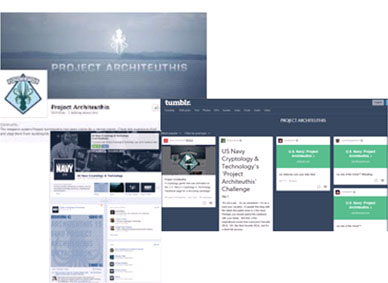
Project Architeuthis Facebook and Tumblr pages

Coded posts from protagonist Maria's fictitious twitter account

Project Architeuthis puzzle clues: #1 visual cryptography puzzle; #3 tetromino puzzle; final clue #7 submarine coordinates
Navy.com served as the primary source for cryptology job information and lead-form activation throughout the challenge.

Navy.com cryptology job-description page
Although some players worked alone to solve the puzzles, many created sub-communities and teamed up to help each other decipher clues and progress through the game. Some groups even chose to communicate in code to keep their messages private and out of the 'line of sight' of the game's enemy force. The game took on a life of its own, mirroring the kind of camaraderie that takes place in the real Navy cryptology community.
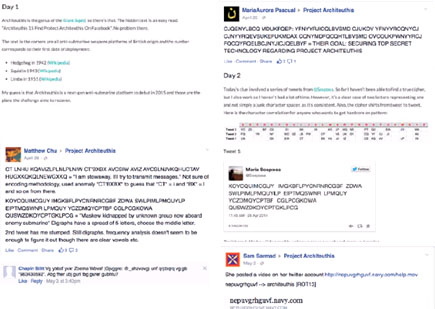
Cryptology sub-community coded posts assisting others
Social effects
The Navy's social media objectives were to get noticed and to create a digital path to job interest. Project Architeuthis enabled it to meet each of these objectives:
Objective 1: Get Navy cryptology noticed
Results: Project Architeuthis content reached 113,494 unique individuals5, 87 prospects for every cryptologist enlistment needed.
Objective 2: Create a digital path to job interest
Engagement results: Project Architeuthis generated6:
- 486,272 total page impressions;
- 243,220 total post impressions;
- 4,631 new followers of the Navy Cryptology and Project Architeuthis Facebook pages;
- 1,100 fan interactions devoted to Project Architeuthis.
Earned media outreach magnified the impact of the campaign amongst this hard-to-reach audience.
- Coverage of Project Architeuthis was picked up by over 50 news services, such as Mashable, The Times and The Telegraph.
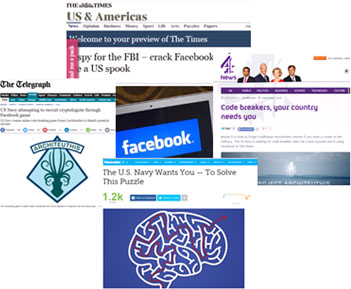
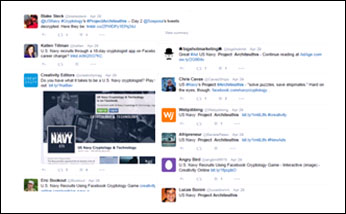
Earned media coverage and advocate posts
A Russian blog even speculated that the winners of Project Architeuthis would be recruited into high-level roles within the US Navy.
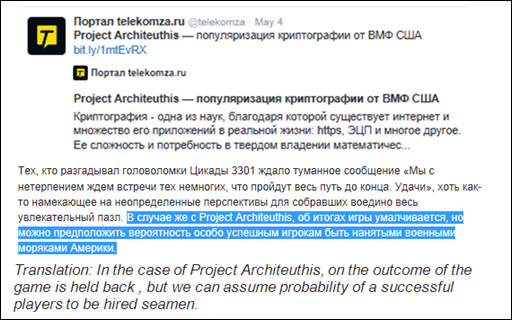
Business effects
The Navy's objective was to reach and recruit 1,291 cryptologists. Project Architeuthis propelled the Navy in achieving this objective, ahead of the 2014 financial year deadline:
Objective 3: Help prospects decode the calling and enlist
Results: Navy met its Cryptology recruiting goal by generating 1,291 enlistments (100% achievement of its goal for new recruits joining in a cryptology rate/job)7.
Lead generation analytics8
Through structuring (previously unstructured) social data, analytics were used to examine the relationships between social-media behaviour and lead generation. By utilizing correlation analytics this way, we are able to demonstrate that Project Architeuthis was a primary driver of enlistments. The analysis revealed significant, highly correlated relationships, which grew stronger as engagement with Project Architeuthis deepened.
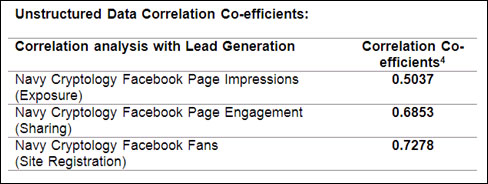
Eliminating other factors
No other factors were in play to influence cryptologist recruitment across the course of the campaign. The marketplace challenges previously mentioned continued to persist throughout the year. Press coverage of the World War II film on cryptology, The Imitation Game, did not begin prior to its release in the US and throughout the world in November 2014 (in the Navy 2015 financial year).
Campaign extension
The success of Project Architeuthis has resulted in the Navy launching a sequel, Operation Sleeper Shark, in January 2015. It once again challenged puzzle enthusiasts with clues revealed via its social-media sites to help stop an even more determined fictitious opposition group.
'Building on the success of Project Architeuthis, we are looking forward to once again engaging an online community of bright, problem-solving people – men and women who are smart, creative, and enjoy being intellectually challenged.' (Captain Dave Bouve, Navy Director of Marketing and Advertising)
Lessons learned
- Do not be discouraged by a lack of budget – a big idea is not dependent on a big budget.
- Try to think about social channels as a part of the creative idea, rather than as ways to amplify it. Where social-media campaigns typically utilize these media to magnify campaign impact to build awareness, the Navy and Lowe Campbell Ewald used social media in a very different way – to reach and engage a virtually impossible-to-reach audience: potential cryptologists. Project Architeuthis represented the perfect fusion of target insights, channel knowledge and creativity, working together as one holistic, powerful idea.
Footnotes
1 Source: Bureau of Labor Statistics, September 2013 versus September 2014
2 Source: New York Times: 'The Rising Cost of Not Going to College', 11th February 2014
3 Source: Navy Youth Tracking Study, May 2014
4 Source: US Navy and CMR/TNS/Kantar 2014
5 Source: Facebook Analytics, Project Architeuthis-specific content 1st September 2013-31st August 2014
6 Source: Facebook Analytics, Project Architeuthis-specific content/mentions/interactions 1st September 2013-31st August 2014
7 Source: US Navy Weekly Accession Recruiting (WAR) Reports, 1st October 2013-31st August 2014
8 Source: US Navy NALTS/Data Central Databases and Facebook Analytics, 1st September 2013-31st August 2014

